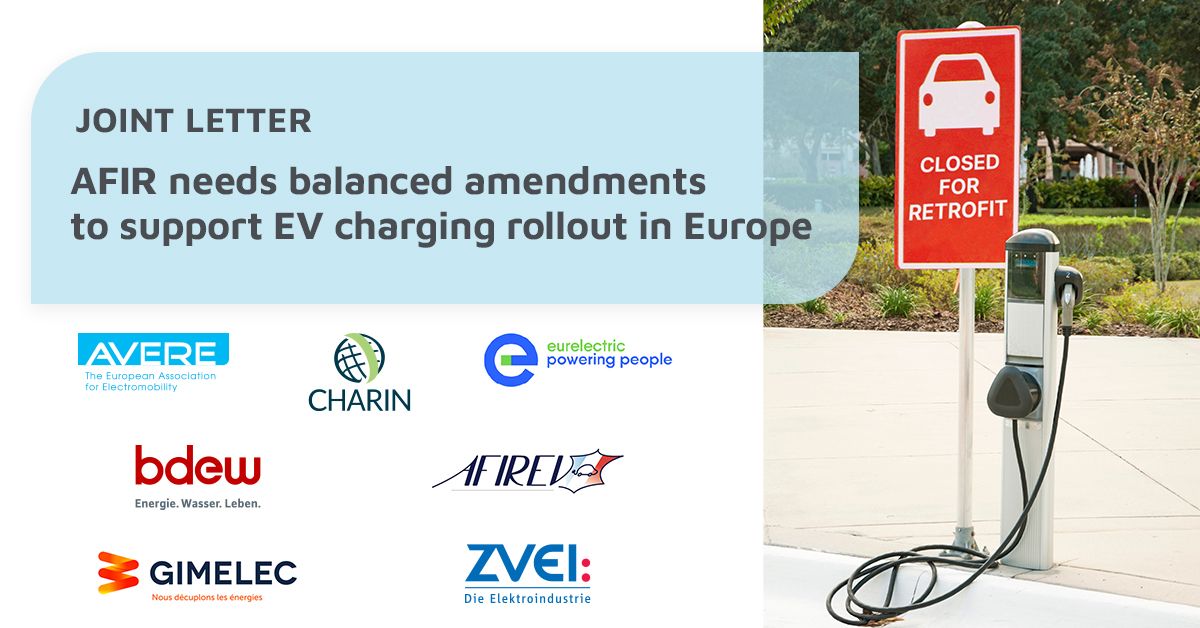AVERE - JOINT LETTER: AFIR NEEDS BALANCED AMENDMENTS TO SUPPORT EV CHARGING ROLLOUT IN EUROPE

We, the undersigned associations, welcome the ambition of the European Parliament to strengthen the Commission’s proposal for the Alternative Fuels Infrastructure Regulation (AFIR). Together, we represent the entire EV charging ecosystem – from grid operators to charging point operators and eMSPs to EV users.
From the TRAN and ITRE draft reports to some of the amendments tabled in ENVI, we are observing a welcome tendency towards setting ambitious targets for charging infrastructure deployment across Europe. We welcome, in principle, the fact that a capacity-based approach is maintained, closely linking the uptake of charging infrastructure to the future development of the EV market. We applaud this ambition and share the aim of building a dense, accessible and user-friendly charging network across the entire Union.
However, a number of burdensome technical provisions has the potential to undermine the achievement of these targets, as well as to hinder the realisation of a consumer-friendly and affordable European charging market. One of the most worrying tendencies in many of the proposed amendments across all committees is a failure to address burdensome retroactive effects of the proposed regulation, or, in some cases, even the introduction of new far-reaching retrofitting requirements for existing charging infrastructure.
These retroactive effects will affect the deployment of new charging infrastructure, necessitating the replacement of existing recharging stations before new capacity can be installed. They will also undermine the business case of charging infrastructure across Europe by ending the useful lifespan of existing recharging stations prematurely. They thereby directly endanger the quick and comprehensive rollout Europe needs over the coming years.
We, therefore, call on the EU to pursue the trajectory of “rollout before retrofits”. In this letter, we are setting out our proposals for what we regard as a sensible compromise on key provisions, ensuring that the regulation remains workable for industry while making charging accessible to all and meeting consumer expectations.
Smart recharging retrofit:
limit requirements to new recharging points
The most striking example of retroactive effects in the Commission’s AFIR proposal is the requirement under article 5(8) for CPOs to ensure that all their normal-power recharging stations are capable of smart recharging by entry into force of the regulation. The Commission proposal regrettably fails to specify an implementation period for this requirement, which would effectively render thousands of existing recharging points “non-compliant overnight” as soon as the regulation enters into force. The amendments so far presented in Parliament either fail to address this issue, in some cases even additionally including fast recharging stations under it, or they introduce very short implementation periods, often requiring compliance by the mid-2020s. As there is no way to retrofit an existing non-smart recharging point with smart recharging capabilities – other than replacing it entirely – these obligations effectively mean many existing recharging points would have to be replaced before deploying additional capacity. In some cases, replacement may be uneconomical, leading to recharging stations being closed entirely.
This cannot be the result or intention of a regulation aimed at guaranteeing a comprehensive charging network across Europe. Without a careful approach to retrofits, the added economic benefits of smart recharging will be undermined by the high cost of replacing existing infrastructure, whilst consumer experience will suffer as this cost will be passed on to them.
CALL TO ACTION
We therefore call on Parliament and Council to:
– Limit the requirement for smart recharging under AFIR to new and replacement normal-power rechargers.
– Postpone application of the requirement for smart recharging for new and replacement recharging stations by 24 months after entry into force to allow industry to adapt.
Payment:
facilitate a sensible compromise on payment cards
We strongly support the facilitation of a seamless, accessible and interoperable European charging network. However, requiring the installation of full card readers with PIN pads at every single charging point across the Union, including existing ones, severely impacts the business case and will hamper rollout across Europe.
This applies especially to normal-power charging: as electromobility becomes a reality for increasingly bigger parts of the population, affordable off-street charging will gain importance for citizens without access to their own driveway. For a comparatively cheap normal-power recharging station, requiring fully fledged card readers would have a disproportionate cost impact, increasing the price of their deployment by up to 200%. This cost would likely be passed on to consumers, while adding little value for them, as charging at or near homes tends to happen on a subscription basis.
For most of the currently deployed AC recharging stations, requiring payment card readers would necessitate a complete replacement because of the lack of space for fitting the necessary devices for card charging. In fact, in some cases the installation of a card reader is entirely impossible. For example, “lantern charging” (charging EVs at street lamp posts) as a convenient solution for off-street parking in cities would be effectively banned by prescribing card readers and PIN pads, as there is usually no space for their installation.
Therefore, the possibility to offer payment via devices using an internet connection for normal-power recharging points should be maintained, while retrofits should be limited to publicly accessible high-power recharging stations with a capacity above 50 kW capacity along the TEN-T network, where consumers may experience gaps in the coverage of their mobility service provider. In addition, the provisions of the Payment Services Directive (PSD II) prescribe the use of a PIN pad for every fifth payment transaction, every payment over €50 or for a cumulative transaction of €150 with the same payment card. The PSD II should therefore be revised, or charging infrastructure should be exempted from its scope.
CALL TO ACTION
In order to strike a sensible balance between facilitating seamless card payment and limiting potential negative implications on the charging market, we propose to build upon the Commission’s original approach:
– 24 months from the date set out in Article 24, require all new charging points of 50 kW and above to feature either payment card readers or offer a contactless functionality that is at least able to read payment cards.
– For under 50 kW, additionally allow the option of devices using an internet connection with which for instance a Quick Response code can be specifically generated and used for the payment transaction.
– Retrofits in regards to payment options should be avoided and could only be required for publicly accessible high-power recharging stations of 50 kW and above along the TEN-T network within a reasonable time frame, in line with normal refurbishment patterns. A technically appropriate timeframe to this end would be between 2030 and 2035, without prejudice to earlier customer-driven refurbishment.
– The 2026 review should explicitly take into consideration the availability of new payment technologies, as well as consumer payment patterns and behaviour.
– Prescribe the availability of ad hoc payment options at the level of any given recharging pool, rather than for each individual station
– Furthermore, extend the exemption of unmanned parking to EV charging infrastructure under the Payment Services Directive II’s strong customer authentication requirements, or revise the directive in order to enable contactless payment without the need for PIN pads.
Pricing and displays:
ensure transparency for consumers, but keep practical implications in mind
Beyond the concerns outlined above, some of the tabled amendments call for overly prescriptive provisions on aspects on how prices should be structured and communicated to consumers.
Some groups seem to be looking to limit billing to payment per kWh in the AFIR’s pricing and display provisions, and to take away the opportunity to also levy time-based or session-based charges. We believe that, in principle, competition and consumer choice should decide on pricing models in the market. At a very minimum, however, scope needs to be left to levy “overtime charges” in case an EV blocks a charging point long beyond the actual duration of the charging session.
On a potential obligation to install physical displays on all recharging stations, while we believe that transparency on pricing for consumers is paramount, similar concerns to the ones outlined above on credit card readers apply. Especially for normal-power charging, the impact on the business case and cost of deployment would be major, added value for consumers marginal, and not all existing technical solutions can accommodate a display. An obligation to make all relevant information easily accessible, for example via digital means, should suffice in these cases. Retrofitting obligations should be avoided.
Similarly, the proposed obligations on eMSPs under article 5(6) are disproportionate, effectively obliging them to make available all supply side price components – at little added benefit to the consumer and with vast implications for the feasibility of their business. Obligations on eMSPs should therefore be aligned with these for CPOs, so that consumers can easily compare the cost of their charging session in price per session, hour, and kWh.
CALL TO ACTION
We therefore recommend to:
– Allow charging providers to offer different ad-hoc pricing models to consumers – including price per session, price per minute or price per kWh. At the very least, maintain scope for proportionate overtime charges.
– Align the price transparency provisions on eMSPs with the above structure, instead of obliging the breakdown of all supply side price components.
– Replace the requirement to “clearly display” prices at each recharging point with an obligation to make such information “easily accessible prior to the start of the recharging session through freely available and widely supported electronic means”
– Avoid any retrofits in regard to price displays.









